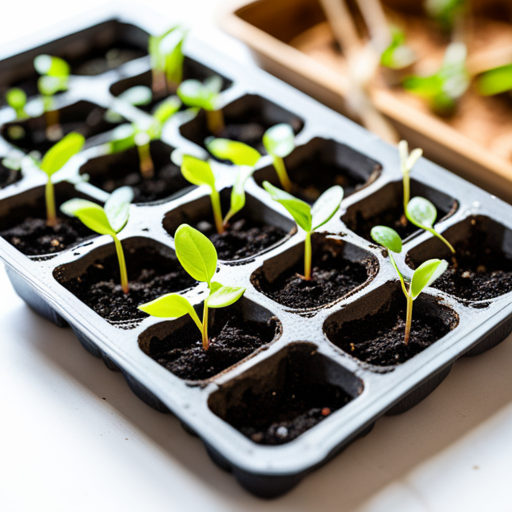
Starting pepper seeds indoors allows gardeners to enjoy a wide variety of peppers, from sweet to spicy, long before outdoor planting season begins. Peppers need a long growing season, so starting seeds indoors gives them the head start they need to produce a plentiful harvest. This guide covers different types of pepper seeds, planting timelines by zone, soil preparation, fertilizers, grow light duration, hardening off, and outdoor planting schedules.
Types of Pepper Seeds to Start Indoors
Several varieties of peppers grow well from seeds started indoors. Sweet bell peppers, banana peppers, and pimentos offer mild flavors, while jalapeños, serranos, and cayenne peppers provide heat. For gardeners who enjoy extra spice, habaneros, ghost peppers, and Carolina reapers make excellent choices. Specialty varieties, such as mini bell peppers, shishitos, and poblano peppers, also grow successfully indoors.
When to Start Pepper Seeds Indoors by Zone
The timing for starting pepper seeds indoors depends on your planting zone. In zones 3-5, start seeds 8-10 weeks before the last frost date, typically in late February or early March. For zones 6-7, start seeds 6-8 weeks before the last frost, around mid-February. Gardeners in zones 8-10 can start seeds 6-8 weeks before the last frost date, usually in January. Always check your local frost dates to ensure proper timing.
Preparing Seed Trays and Soil
To plant pepper seeds indoors, use seed-starting trays or small pots with drainage holes. Fill the trays with a light, well-draining seed-starting mix. Avoid using garden soil, which can be too heavy and may contain pathogens. Dampen the soil before planting to create a moist environment for seed germination.
Planting Pepper Seeds
Plant pepper seeds about ¼ inch deep in the prepared soil. Place 2-3 seeds in each cell or pot to ensure germination. Lightly cover the seeds with soil and mist the surface with water. Cover the trays with plastic domes or clear plastic wrap to trap humidity, which speeds up germination. Place the trays in a warm area, ideally between 70-85°F, since peppers need warmth to sprout.
Fertilizing Pepper Seedlings
Pepper seeds do not need fertilizer until they sprout and grow their first true leaves. Once seedlings appear, feed them with a half-strength liquid fertilizer every two weeks. Use a balanced fertilizer, such as 10-10-10 or 20-20-20, to support early growth. As the plants mature, increase the fertilizer concentration to promote stronger stems and healthy leaves.
Light Requirements and Grow Lights
Pepper seedlings need plenty of light to grow strong and avoid becoming leggy. Place trays under grow lights for 14-16 hours each day. Position the lights about 2-3 inches above the plants and adjust the height as the seedlings grow. Using a timer ensures consistent light exposure. Natural sunlight from a south-facing window can supplement grow lights, but artificial lighting often works best during early growth.
Hardening Off Pepper Plants
Hardening off prepares indoor-grown seedlings for outdoor conditions. Begin this process about 10-14 days before transplanting. Start by placing seedlings outside in a shaded area for 1-2 hours each day, gradually increasing their time outdoors. Slowly expose them to more sunlight and wind while reducing watering slightly to toughen them up. Bring the plants back indoors if temperatures drop below 50°F.
When and How to Plant Outdoors
Peppers thrive in warm soil, so wait until outdoor temperatures consistently stay above 60°F before transplanting. In most regions, this occurs 2-3 weeks after the last frost date. Choose a sunny location with well-draining soil and space plants 18-24 inches apart. Dig holes slightly larger than the root ball of each seedling and mix in compost or aged manure for added nutrients. Plant seedlings at the same depth they grew indoors and water thoroughly after planting.
Happy Pepper Gardening!
Keep the soil moist but not waterlogged to prevent root rot. Mulch around the base of plants to retain moisture and reduce weeds. Continue fertilizing every 3-4 weeks with a balanced or low-nitrogen fertilizer to support fruit production. Monitor for pests such as aphids and spider mites, and treat infestations quickly with insecticidal soap or neem oil.
By starting pepper seeds indoors and following these steps, you can enjoy a variety of peppers all season long. With proper care, healthy transplants lead to a bountiful harvest, whether you grow sweet or spicy varieties.
Please be sure to check out my Gardening Blog Post Page for more tips on all types of gardening. Including Seed Saving, Seed Starting, Orchids, Water Gardening, Coldframe Gardening, Indoor Bulb Gardening, Hydroponics, Container Gardening, Mums, Herbs, African Violets, planting Bulbs, Flower Gardening, Vegetable and Fruit Gardening, Indoor Houseplants of all kinds, Cactus, Succulents, Hanging plants, Deer resistant plants and even Bird, Bee, Butterfly and Hummingbird Gardens!
